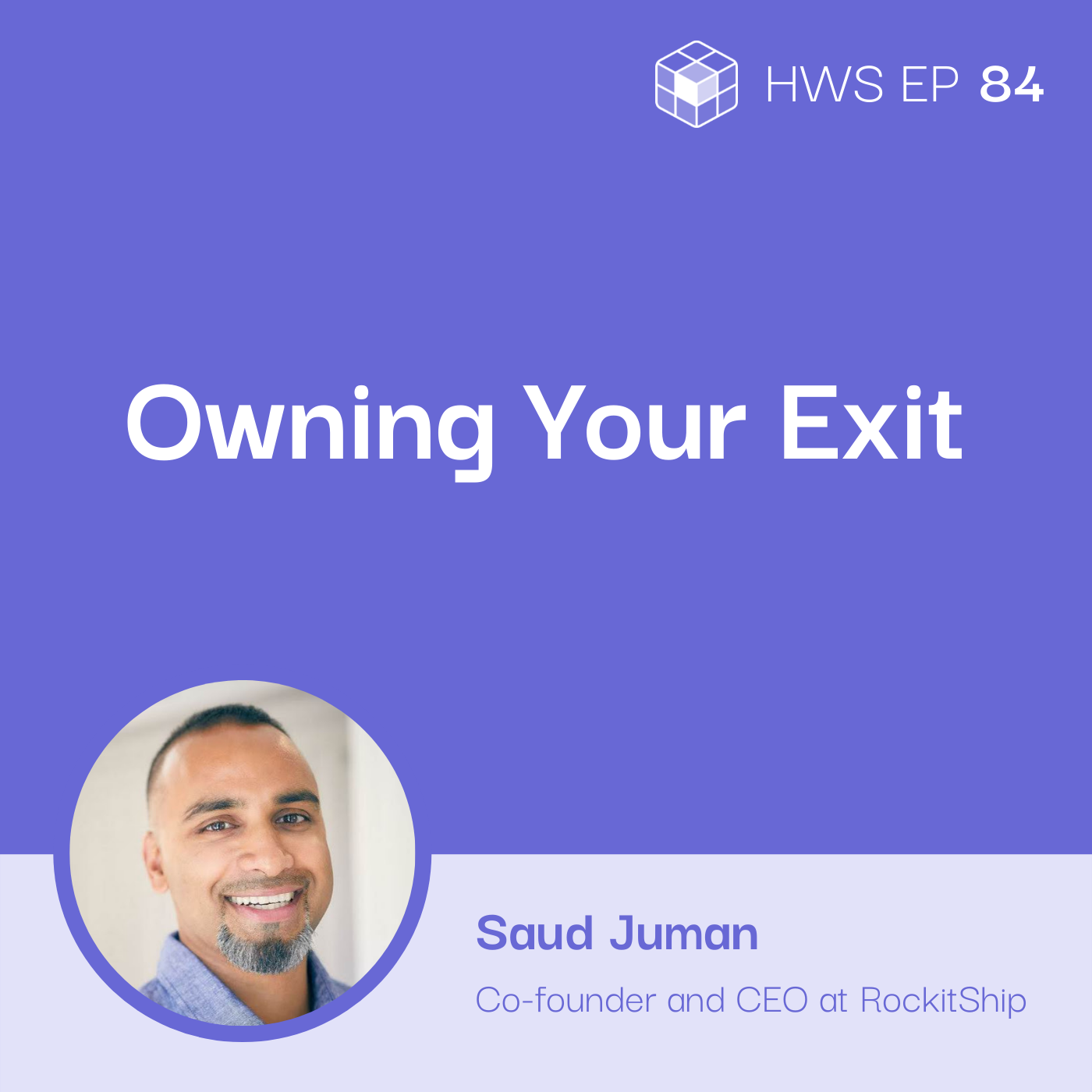Listen on:
Table of Contents:
Problem: How Do Own and Take Control of Your Exit
Every entrepreneurial journey is a cycle. Serial entrepreneurs often wonder what’s next. How do you know when and how you can take control of your exit?
Well, I’ve always owned my own exit at each chapter of my career, at least. And what that means is proactively deciding to change. Sometimes that means pivoting or moving on before any kind of drastic, dramatic negative thing ends up happening.
Graceful Exit to Your New Venture
Startup founders treat their businesses like their children. It takes years to care for, invest in, and ensure your investment flourishes. As it grows up, it needs to become independent in order to advance. As a startup matures, the relationship with your venture evolves naturally and on some occasions, you’ll have to exit so both founder and start-up can grow separately. Entrepreneurs thrive on the excitement of starting new businesses, cooking up new ideas, and solving early stage problems. They thrive on fresh and new challenges.
Step #1: Listen To Your Gut and Proactively Think About Change
Throughout his career, Saud says his gut instinct has never let him down. It’s great to read books and listen to podcasts to learn about how to improve and make changes in life, but it’s also good to listen to your instincts, analyze and plan for your next step based on your current surroundings.
I would tell that 20 something year old kid, listen to your gut, listen to your heart, listen to that voice inside of you because that always guides you in the right direction. More so than any podcast. No offense to this podcast, book, speaker thought leader influencer. all of that stuff.
Step #2: Clear Your Mind and Disconnect
Saud shares how meditation helped him. By taking the time to be silent and connect with yourself, you’re able to weigh whether you’re going in the right direction or not. He encourages listeners to do things that give them joy, whether it’s sports or other hobbies. Visualize what you will do next. Ask yourself, what will be my new direction on the path to success?
As you do this, Saud reminds us that we don’t just let our hearts decide. Bring together the feelings of the heart and the thoughts of the mind. Make sure your emotions are in harmony with your logic.
I sat there. And it’s just a big open carpeted area. I sat there in silence… And I started asking this one sentence, but not out loud, just like in my heart. I kept on saying, show me the path of excellence I’m supposed to take in order to make a difference in this world. Show me the one path of excellence I’m supposed to take. And I kept on asking that. I left that night. And then I went back the following night. And the following night. And I did that for almost 10 months. I don’t know why I just did it for almost 10 months. And somewhere around month three or four, the communication became two-way in a way. I kept on getting this intuition, this hunch, this flash that, okay, if you’re going to get a second chance, it’s going to be in healthcare. You’re going to impact people’s health. That manifested itself into the startup that I was going to start.
Step #3: Study and Understand Your Cycle
Entrepreneurs sometimes stop after the first exit. Yet, yearn for new challenges afterward. Some people are brave enough to become second-time founders, while others are complacent and fear another exit. Saud mentioned at the beginning of the episode that entrepreneurship is a cycle, a journey that ends and then begins again. He emphasized the importance of thinking hard and setting goals on how many cycles of setting-up, grinding, and exiting can you still take. In the end, success doesn’t come from staying stagnant. If you are considering exiting, ask yourself how many cycles you can handle after this?
Then I realized I’m not done yet. I have probably two or three more cycles left of starting and birthing ventures. And, once RockitShip is done, however long that takes, five, seven years… I know I have another cycle after that. I’m not quite sure I might have to switch the game up a little bit. But I think acknowledging how many cycles you have left is a really important thing because that lets you know if you’ve got to switch completely to something else or maybe you have more cycles left in you.
Step #4: Stay Fresh, Creative, and Hungry
Sometimes, complacency makes you stagnant. After an exit, it’s important to take a break and give yourself a fresh perspective. Spend time doing things you love. Give yourself enough space between ventures. Enough space based on what works for you. Enough time to still keep the drive. Intentionally stay hungry by starting again, but don’t forget the learnings from your last exit and bring it with you on the next journey.
I think you’ve got to dig within yourself to figure out what the motivation is going to be to do that next thing. You’ve got to manufacture constraints, barriers, techniques to drive the hunger. You gotta be hungry and humble again because if you’re coming at it from like, “I’ve been successful, I know everything”. You know what, you’re not going to be hungry enough to do that next thing, and that hunger is such a requirement. You’ve got to find ways in the next chapter to manufacture the hunger while also bringing along all the lessons and wisdom you learned.
Resources about business and culture, which Saud recommends:
Think and Grow Rich by Napoleon Hill (1937; Currently Published by Napoleon Hill Foundation)
Blueprint to a Billion: 7 Essentials to Achieve Exponential Growth by David G. Thomson
Blue Ocean Strategy: How to Create Uncontested Market Space and Make the Competition Irrelevant by W. Chan Kim
Why Disconnecting From Time-to-Time Matters
You can take that disconnected time to actually solve a lot of problems. So for example, one practice at the last tech company, and now I’m doing this with RockitShip regularly. Once a week, I will sit in a room with no stimulus. No computer, no phone, or anything else. Dark, sitting in a chair, turn out the light. And I will focus my mind on the business, let’s say, I will just think about the business. And this is a practice actually that I read that many Asian entrepreneurs do. And I just think about, okay what’s going on with RockitShip? How is the new version of the product going? What do we have to do with client success? What do we have to do with sales? Right? I’m just thinking. And the gleams that you get out of that hour, it’s phenomenal, but you’ve got to move past the point of being bored. You’ll be bored. Then you’ll be pissed off at yourself for doing this cause you feel like you’re wasting time, and then you’ll get to the point of saying, aha there’s something here! So that disconnected time to focus on things really, really helps.
This interview is part of the How We Solve podcast. To hear more from industry experts who are solving everyday business problems, check us out on Spotify, Apple Podcasts, and on our website.
About the guest

Saud Juman
Is a repeat entrepreneur. His last venture, PolicyMedical was acquired by Susquehanna Growth Equity. He is currently scaling RockitShip, a start-up he Co-founded with 2 other partners. His decision came after his exit at PolicyMedical. After that, his transformation from human-doing to becoming a human-being again, pushed him to go back to the entrepreneurial game. Saud is an advisor, investor, and speaker who talks about his "Owning Your Exit" story with entrepreneurs, executives, youth and students. He focuses on sharing how beneficial it is to get ahead of forced change and proactively navigating your pivots.
How people can people reach the guest:
LinkedIn: Saud Juman
Twitter: @SaudJuman
Email: saudjuman@gmail.com
Company Website: www.rockitship.io
Personal Website & Profile: www.saudjuman.io
Listen on:
